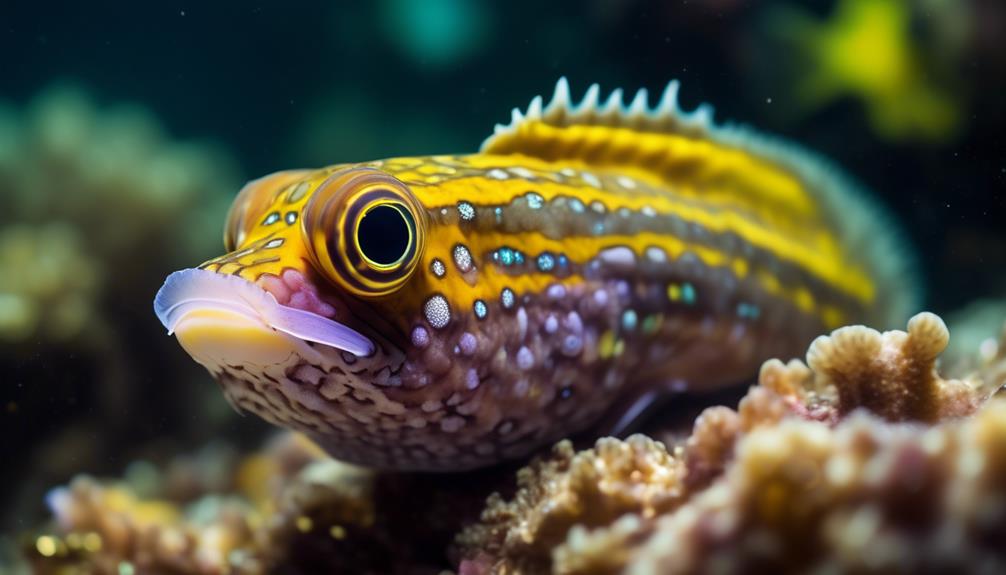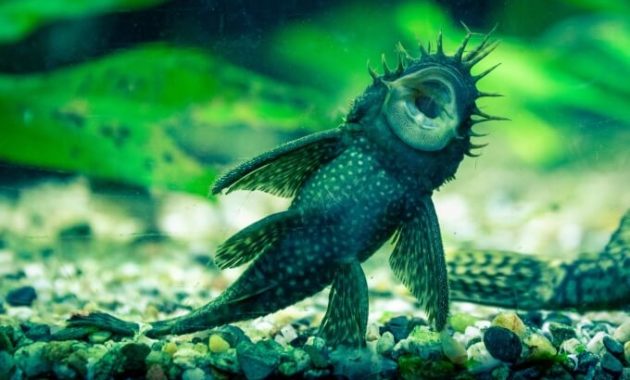
By pure coincidence, you stumbled upon a hidden gem in the vast ocean – the colorful world of blennies. As you immerse yourself in this discussion, you will uncover the fascinating secrets behind these captivating marine creatures.
From their unique appearance to their compatibility in aquariums, there is much to learn about these small yet enchanting fish. So, get ready to embark on a journey where vibrant colors and intriguing behaviors await.
But be warned, the deeper you dive into the world of blennies, the more you will be drawn in by their allure, leaving you eager to discover more.
Key Takeaways
- Blennies are a diverse species of marine fish with various families and vibrant colors.
- They are suitable for beginner aquarists due to their hardy nature and reclusive behavior.
- Blennies prefer medium-sized aquariums with suitable water conditions and tank mates such as angelfish, clownfish, and gobies.
- These fish require rock cover, hiding places, and a soft sand substrate for their burrowing and digging behavior.
Blennies: Small, Colorful Fish
Blennies, these small and colorful fish, are a delightful addition to any marine aquarium. With their vibrant hues and unique characteristics, they bring a burst of color and life to your tank.
These fish are part of the blenny species, which is composed of six distinct families. Blennies are similar in appearance to gobies, with their small size, long bodies, and large eyes and heads. Despite their petite stature, blennies are hardy and can thrive in various tank conditions, making them suitable for beginner aquarists.
Originating from the tropical regions of the Indo-Pacific Ocean, blennies prefer a bottom swimming region in the tank. They can coexist peacefully with other fish, but may display territorial behavior towards their own species.
Proper care, including suitable tank mates, water conditions, and feeding habits, ensures that these vibrant fish thrive in your aquarium.
Different Families of Blennies

With their small size and vibrant colors, blennies from different families create a captivating display in marine aquariums. These unique families of blennies offer a diverse range of species, each with its own distinctive characteristics. Here are four families of blennies that will add a splash of color to your aquarium:
- Combtooth Blennies: Known for their comb-like teeth, these blennies have elongated bodies and can be found in a variety of colors, including yellow, brown, and black.
- Fangblennies: These blennies have sharp fangs and are often brightly colored, with shades of blue, orange, and red. They're known for their interesting feeding behavior, which involves mimicking cleaner fish to trick larger predators.
- Rockskipper Blennies: As their name suggests, these blennies have a unique ability to skip and hop on rocks. They're usually small in size and come in shades of brown and gray, blending in with their rocky surroundings.
- Blenny Gobies: These blennies have a close resemblance to gobies and are often found in vibrant colors such as blue, yellow, and purple. They're known for their playful behavior and can often be seen darting in and out of rock crevices.
Adding blennies from different families to your aquarium won't only create a visually stunning display but also provide an opportunity to observe the fascinating behaviors and interactions of these captivating fish.
Appearance and Characteristics of Blennies

Blennies display a wide range of vibrant colors and unique characteristics that make them an eye-catching addition to any aquarium. These small marine fish come in various species, each with its own distinct appearance and features. Here is a table that highlights some of the most popular blenny species and their characteristics:
| Blenny Species | Colors | Characteristics |
|---|---|---|
| Barnacle Blenny | Red, yellow, brown | Mimics barnacles, camouflaging in the reef |
| Bicolor Blenny | Blue, orange | Two distinct color bands along its body |
| Black Combtooth | Black | Comb-like teeth for scraping algae from rocks |
| Canary Blenny | Yellow | Bright yellow coloration |
Blennies are known for their elongated bodies, large eyes, and heads, giving them a unique appearance. They also have a variety of behaviors, such as burrowing, hiding in rock crevices, and even perching on corals. With their vibrant colors and fascinating characteristics, blennies are sure to captivate anyone who observes them in an aquarium setting.
Blennies in the Aquarium: Tank Size and Mates

Now let's focus on setting up an ideal environment for blennies in your aquarium, including the appropriate tank size and compatible tank mates.
Here's what you need to know:
- Tank Size: Blennies can be kept in medium-sized aquariums, with a recommended size of 30 gallons. This will provide them with enough space to swim and explore.
- Bottom Swimming Region: Blennies prefer a bottom swimming region in the tank. Make sure to provide them with plenty of rocks and hiding places where they can feel secure.
- Compatible Tank Mates: Suitable tank mates for blennies include angelfish, boxfish, clownfish, damsels, gobies, and puffers. These fish are known to coexist peacefully with blennies.
- Water Conditions: Blennies require suitable water conditions in the tank. Maintain proper temperature, salinity, and pH levels to ensure their well-being.
Creating the Perfect Habitat for Blennies

To create an optimal habitat for blennies, it is important to consider their natural preferences and provide them with suitable tank conditions. Blennies prefer a tank with rock cover and hiding places, as well as a soft sand substrate for burrowing and digging. It is recommended to have a medium-sized aquarium of at least 30 gallons, with firmly fixed rock fixtures to prevent toppling. When choosing tank mates for blennies, angelfish, boxfish, clownfish, damsels, gobies, and puffers are suitable options. Blennies are generally peaceful towards other fish, but they can be territorial and aggressive towards their own species. In order to ensure their well-being, it is also important to provide them with a diverse diet of live, frozen, and dried foods.
| Habitat Preferences | Tank Conditions |
|---|---|
| Rock cover and hiding places | Medium-sized aquarium (at least 30 gallons) |
| Soft sand substrate for burrowing | Firmly fixed rock fixtures |
| Bottom swimming region in the tank | Suitable tank mates: angelfish, boxfish, clownfish, damsels, gobies, puffers |
| Peaceful towards other fish, but territorial and aggressive towards their own species | Diverse diet of live, frozen, and dried foods |
Feeding and Care for Blennies

After creating the perfect habitat for your blennies, it's essential to ensure their proper feeding and care. Here are four important tips to help you keep your blennies healthy and happy:
- Provide a varied diet: Blennies are gregarious feeders and accept various types of live, frozen, and dried foods. Make sure to offer a mix of food options to meet their nutritional needs.
- Maintain water quality: Blennies require suitable water conditions in the tank. Regularly test the water parameters and perform water changes to keep ammonia, nitrite, and nitrate levels in check.
- Keep the tank clean: Blennies produce waste like any other fish, so it's crucial to maintain good tank hygiene. Regularly clean the substrate, remove uneaten food, and perform routine tank maintenance to prevent the buildup of harmful substances.
- Monitor behavior and health: Keep a close eye on your blennies' behavior and appearance. Look out for signs of stress, illness, or aggression. If you notice any abnormalities, take appropriate action, such as adjusting feeding or seeking veterinary advice.
Breeding Challenges With Blennies

Breeding blennies in captivity poses significant challenges, making it a complex endeavor for marine aquarium enthusiasts. Blennies are not commonly bred in aquariums, and there are no reports of successful breeding. In the wild, blennies lay adhesive eggs that stick to rocks and coral on the ocean bed. However, replicating this natural breeding behavior in a captive environment is difficult. Table 1 below summarizes the main challenges faced when attempting to breed blennies in aquariums.
| Breeding Challenges With Blennies |
|---|
| 1. Replicating natural breeding behavior |
| 2. Providing suitable conditions for egg attachment |
| 3. Maintaining water quality conducive to breeding |
| 4. Overcoming territorial aggression among blennies |
These challenges require a deep understanding of blenny behavior, precise water parameters, and careful observation. Despite the difficulties, successful breeding attempts could contribute to the conservation and sustainability of blenny populations in the future.
Explore the Diverse Varieties of Blennies

Now let's dive into the fascinating world of blennies and explore the incredible variety of species and colors they come in. Blennies are known for their vibrant colors and unique characteristics, which make them a popular choice for marine aquarium enthusiasts.
Here are four examples of the diverse varieties of blennies you can find:
- Barnacle Blenny: This blenny species has a striking blue and yellow coloration, resembling the colors of a barnacle-encrusted surface.
- Bicolor Blenny: As the name suggests, this blenny displays a beautiful combination of two colors, typically a vibrant yellow and a contrasting shade of blue or orange.
- Black Combtooth Blenny: This species stands out with its dark, almost black, body coloration, accented by bright blue eyes and a distinctive comb-like pattern on its head.
- Canary Blenny: With its vibrant yellow body and contrasting black eyes, the canary blenny is a true standout in any aquarium.
These are just a few examples of the stunning variety of blennies available, each offering its own unique colors and patterns. Adding these fish to your aquarium will surely bring a visual spectacle to your underwater world.
Vibrant Colors of Blennies: A Visual Delight

Blennies captivate with their vibrant colors, creating a visual delight in any marine aquarium. These small fish come in a variety of stunning hues, ranging from red, yellow, and orange to blue, purple, and even black. Each blenny species has its own unique coloration, adding diversity and visual appeal to aquariums. To give you a better idea of the vibrant colors of blennies, here is a visual representation:
| Species | Color |
|---|---|
| Barnacle Blenny | Red, orange, and yellow |
| Bicolor Blenny | Blue and yellow |
| Black Combtooth | Black and white |
| Canary Blenny | Yellow and white |
| Black Sailfin | Black and purple |
Blennies' vibrant colors not only enhance the overall aesthetic of your aquarium, but they also serve as a conversation starter and a true visual delight.
Why Blennies Are Popular in Marine Aquariums

Blennies have gained immense popularity among marine aquarium enthusiasts due to their vibrant colors and unique characteristics. Here's why they're a popular choice for your aquarium:
- Colorful Display: Blennies come in a variety of vibrant colors, adding a burst of visual appeal to your tank. From reds and yellows to blues and purples, these fish bring a splash of beauty to your underwater world.
- Small Size: Blennies are small in size, making them suitable for medium-sized aquariums. Their compact bodies allow you to create a diverse and captivating environment without needing a massive tank.
- Hardy Nature: These fish are known for their hardiness, making them ideal for beginner aquarists. They're resilient and can adapt to different water conditions, ensuring a higher chance of success in keeping them.
- Unique Personalities: Blennies have quirky and interesting behaviors that make them a joy to observe. From their comical antics to their burrowing and digging habits, these fish bring a touch of charm and entertainment to your aquarium.
With their vibrant colors, hardy nature, and unique personalities, it's no wonder that blennies have become a popular choice for marine aquarium enthusiasts.
Tips for Keeping Blennies Happy and Healthy

After learning about why blennies are popular in marine aquariums, let's now explore some key tips for ensuring the happiness and health of these colorful fish.
First, make sure to provide a suitable tank for your blennies. They prefer a medium-sized aquarium of at least 30 gallons with a soft sand substrate and plenty of rock cover for hiding.
It's also important to choose compatible tank mates such as angelfish, clownfish, and gobies. Maintain proper water conditions, including a temperature of around 78-82°F and a pH level of 8.1-8.4.
Blennies are gregarious feeders, so offer a varied diet of live, frozen, and dried foods.
Lastly, create a peaceful environment by preventing overcrowding and providing ample hiding places.
Frequently Asked Questions
How Do Blennies Defend Themselves From Predators in the Wild?
Blennies defend themselves from predators in the wild by using various tactics. They rely on their agility and speed to escape, camouflage to blend in with their surroundings, and venomous bites to deter attackers.
Are Blennies Suitable for Reef Aquariums?
Yes, blennies are suitable for reef aquariums. They add vibrant colors and diversity to your tank. Just make sure to provide suitable tank mates and water conditions for them to thrive.
What Is the Lifespan of Blennies in Captivity?
Blennies can live up to 10 years in captivity if provided with proper care. Keep their tank clean, feed them a varied diet, and create a suitable environment with hiding spots and rock cover.
Can Blennies Change Their Colors?
Yes, blennies can change their colors. They have the ability to change their pigment cells, known as chromatophores, which allows them to blend into their surroundings or display vibrant colors for communication and courtship.
Are Blennies Prone to Any Specific Diseases or Health Issues?
Blennies, like any other fish, can be prone to specific diseases and health issues. It is important to maintain proper water conditions, provide a balanced diet, and monitor their behavior and appearance for any signs of illness.
What Makes Blennies Colorful and Interesting in the Underwater World?
Blennies are known for their vibrant hues and unusual patterns, making them a standout in the world of wrasse. These small, colorful fish also have fascinating behaviors, such as their unique swimming style and ability to change color to blend in with their surroundings.
Conclusion
So, now you know all about the beautiful and fascinating world of blennies. These small, colorful fish make a perfect addition to any aquarium.
With their unique appearance and hardy nature, they're a great choice for beginner aquarists. From the ideal tank size to suitable tank mates, we've covered everything you need to know to create the perfect habitat for your blennies.
So go ahead and dive into the colorful world of blennies, and enjoy the vibrant beauty they bring to your aquarium!




